助您决策的交易策略
探索实用策略与方法,提升您的规划、分析与执行力。


Most traders understand EA portfolio balance through the lens of traditional risk management — controlling position sizes, diversifying currency pairs, or limiting exposure per trade.
But in automated trading, balance is about deliberately constructing a portfolio where different strategies complement each other, measuring their collective performance, and actively managing the mix based on those measurements.
The goal is to create a “book” of EAs that can help diversify performance over time, even when individual strategies hit rough patches.
A diversified mix of EAs across timeframes and assets can, in some cases, reduce reliance on any single strategy. This approach reduces dependency on any single EA’s performance, smooths your overall equity curve, and builds resilience across changing market conditions.
It’s about running the right mix, identifying gaps in your coverage, and viewing your automated trading operation as an integrated whole rather than a collection of independent systems.
Basic Evaluation Metrics – Your Start Point
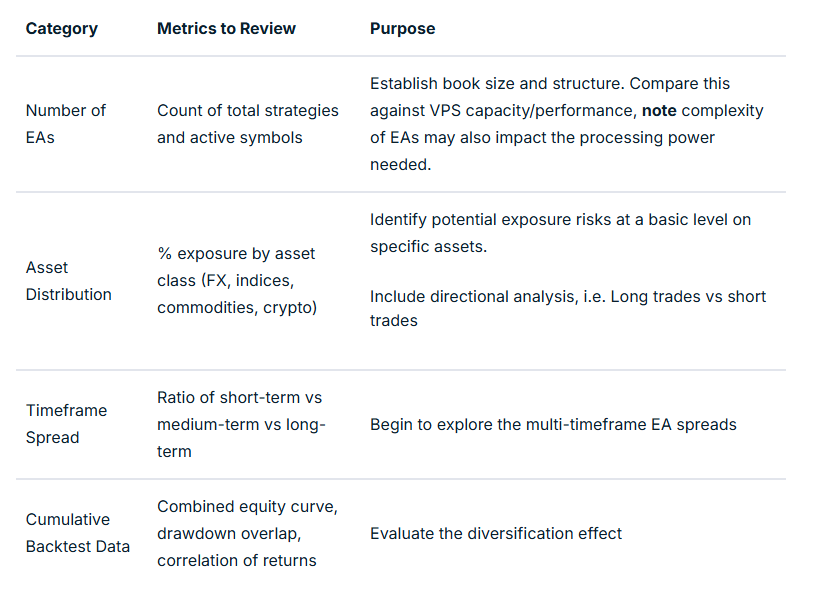
Temporal (timeframe) Balancing
When combined, a timeframe balance (even on the same model and instrument) can help flatten equity swings.
For example, a losing phase in a fast-acting M15 EA can often coincide with a profitable run in an H4 trend model.
Combining this with some market regime and sessional analysis can be beneficial.
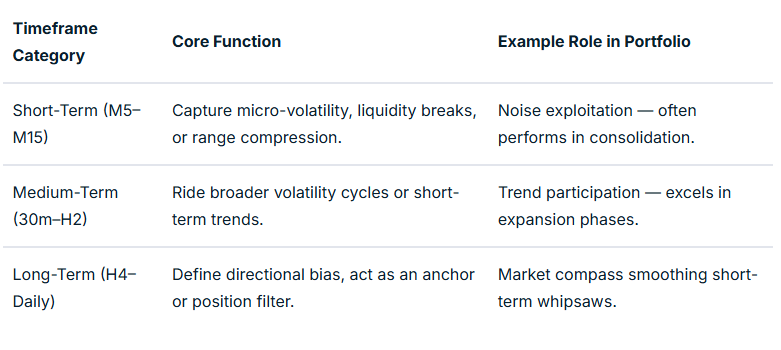
Asset Balance: Managing Systemic Correlation Risk
Running five different EAs on USDJPY might feel diversified if each uses different entry logic, even though they share the same systemic market driver.
But in an EA context, correlation measurement is not necessarily between prices, but between EA returns (equity changes) relating to specific strategies in specific market conditions.
Two EAs on the same symbol might use completely different logic and thus have near-zero correlation.
Conversely, two EAs on a different symbol may feel as though they should offer some balance, but if highly correlated in specific market conditions may not achieve your balancing aim.
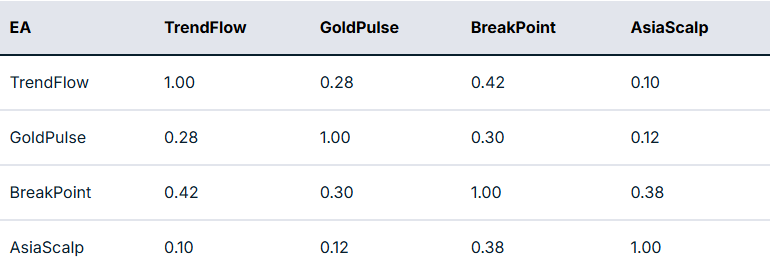
In practical terms, the next step is to take this measurement and map it to potential actionable interventions.
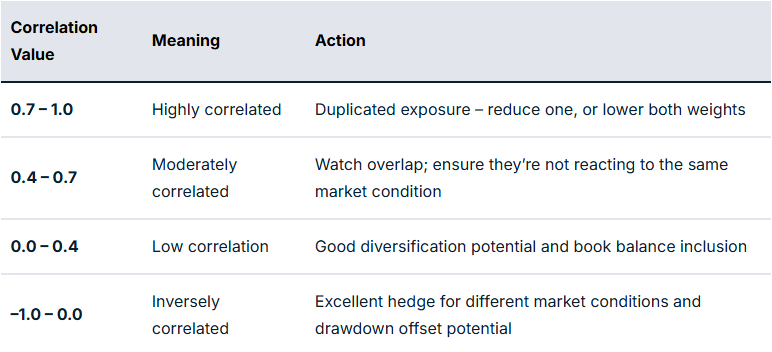
For example, if you have a EURUSD Trend EA and a GBPUSD Breakout EA with a correlation of 0.85, they are behaving like twins in performance related to specific market circumstances. And so you may want to limit exposure to some degree if you are finding that there are many relationships like this.
However, if your gold mean reversion EA correlates 0.25 compared to the rest of your book, this may offer some balance through reducing portfolio drawdown overlap.
Directional and Sentiment Balance
Markets are commonly described as risk-on or risk-off. This bias at any particular time is very likely to impact EA performance, dependent on how well balanced you are to deal with each scenario.
You may have heard the old market cliché of “up the staircase and down the elevator shaft” to describe how prices may move in alternative directions. It does appear that optimisation for each direction, rather than EAs that trade long and short, may offer better outcomes as two separate EAs rather than one catch-all.
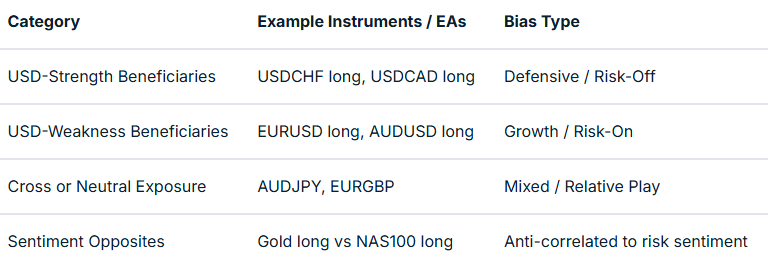
Market Regime and Volatility Balance
Trend and volatility states can have a profound impact on price action, whether as part of a discretionary or EA trading system. Much of this has a direct relationship to time of day, including the nature of individual sessions.
We have a market regime filter that incorporates trend and volatility factors in many EAs to account for this. This can be mapped and tested on a backtest and in a live environment to give evidence of strategy suitability for specific market conditions.
For example, mean reversion strategies may work well in the Asian session but less so in strongly trending markets and the higher volatility of the early part of the US session.
As part of balancing, you are asking questions as to whether you actually have EA strategies suited to different market regimes in place, or are you using these together to optimise book performance?
The table below summarises such an approach of regime vs market mapping:
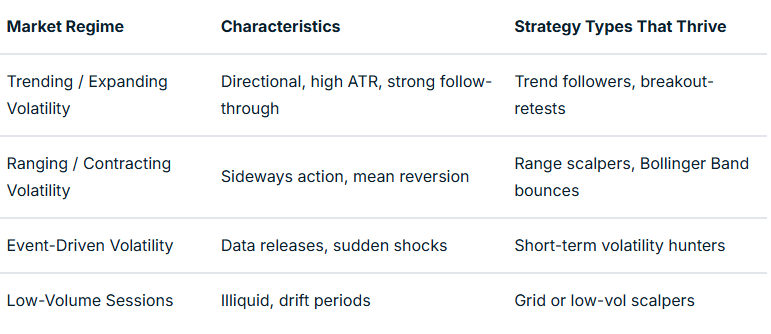
Multi-Level Analysis: From Composition to Interaction
Once your book is structured, the challenge is to turn it into something workable. An additional layer of refinement that turns theory and measurement into something meaningful in action is where any difference will be made.
This “closing the circle” is based on evidence and a true understanding of how your EAs are behaving together. It is the step that takes you to the point where automation can begin to move to the next level.
Mapping relationships with robust and detailed performance evaluation will take time to provide evidence that these are actually making a difference in meeting balancing aims.
To really excel, you should have systems in place that allow ongoing evaluation of the approaches you are using and advise of refinements that may improve things over time.
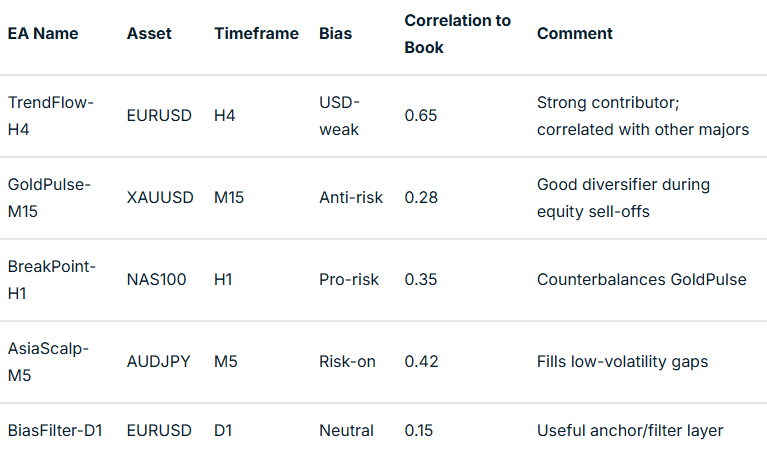
What Next? – Implementing Balance in Practice
Theory must ultimately translate into an executable EA book. A plan of action with landmarks to show progress and maintain motivation is crucial in this approach.
Defining classification tags, setting risk weights, and building monitoring dashboards are all worth consideration.
Advanced EA traders could also consider a supervisory ‘Sentinel’ EA, or ‘mothership’ approach, to enable or disable EAs dynamically based on underlying market metrics and external information integrated into EA coding decision-making.
Final Thoughts
A balanced EA portfolio is not generated by accident; it is well-thought-out, evidence-based and a continuously developing architecture. It is designed to offer improved risk management across your EA portfolio and improved trading outcomes.
Your process begins with mapping your existing strategies by number, asset, and timeframe, then expands into analysing correlations, directional bias, and volatility regimes.
When you reach the stage where one EA’s drawdown is another’s opportunity, you are no longer simply trading models but managing a system of EA systems. To finish, ask yourself the question, “Could this approach contribute to improved outcomes over time?”. If your answer is “yes,” then your mission is clear.
If you are interested in learning more about adding EAs to your trading toolbox, join the new GO EA Programme (coming soon) by contacting [email protected].


Expert Advisors are programs which are configured to execute trades or read market price movements. When a parameter is met or triggered, it commands the EA to open or close trades on your behalf whilst you are otherwise engaged or sleeping. EAs are compatible to be used on the Metatrader 4 and 5 systems.
Algorithmic trading is a method of executing orders using automated pre-programmed trading instructions accounting for variables such as time, price, and volume. This type of trading attempts to leverage the speed and computational resources of computers relative to human traders. In the twenty-first century, algorithmic trading has been gaining traction with both retail and institutional traders.
It is widely used by investment banks, pension funds, mutual funds, hedge funds that may need to spread out the execution of a larger order or perform trades too fast for human traders to react to. It is now also widely available to retail clients. A study in 2019 showed that around 92% of trading in the Forex market was performed by trading algorithms rather than humans.
What are the advantages of using EA’s? Timesaving – The Forex market is open 24 hours. As a trader you are always looking for an opening in the market for you to execute an order, however, as a human you need to be able to sleep to operate normally, especially if you want to live a healthy life.
With an EA in place, you can time the market, set alerts, watch various markets simultaneously, set open and close trades yourself or allow it to open and close trades on your behalf. For a lot of forex traders who’d like to profit from market movements during a particular trading session but are stuck in a different time zone, using an expert advisor means that they don’t need to worry about trading sleep for pips. Emotionless Trading – The market is wholly affected by emotion, whether the emotion makes you want to buy or sell an asset is down to how you understand the information or how you perceive the charts.
With emotion you can either be gripped in a circle of greed or a loss of confidence which can cloud your thinking and deviate from a trusted strategy. An EA does not suffer from these as it just needs to meet various mathematical parameters to work. Expert advisors are wired to stick to system commands and take valid trade signals, without feeling pain from losses or joy from wins.
Backtesting - Another advantage of having an expert advisor is the ease of conducting backtests, particularly on an MT4 platform. In fact, Babypips have a short tutorial on how to backtest and EA on MT4 and you’d be surprised to know that it just takes a few clicks to see how a system fared over several years. This is mainly used, to make sure that the EA you have acquired, works in the way you want it to work before letting it loose on your live account with real money at stake.
Quick and Flexible – EAs can open and close trades in a blink of an eye; whilst humans tend to second guess these actions by taking price movements and reading indicators, an EA is built to take these decisions with mathematical precision. Depending on the EA you are also able to check multiple markets and have various EAs on one system at the same time. Some of these features are also extremely useful for short term traders who trade on smaller movements of 1 – minute to 5 – minutes charts.
Human Error and Accessibility – Human error have cost many a trader in years past, opening the wrong direction on trades, making the size of the position too big or too small, or opening a trade whilst misreading the technical can all have a negative effect on your trading experience. Having an EA can limit these errors as EAs are programmed to your specifications and they would never deviate from that, unless they are not set properly to begin with, but this is the reason why you would always backtest! EAs are available with a decent variety and with great accessibility to these programs, it is no hard to see why they are becoming the automated popular choice for traders.
In my follow up article on this subject, I will talk about the use of a VPS and popular EAs. If you like to incorporate your MT4/5 systems with EAs, you can talk to one of our Account Managers who will be happy to talk you through the process, feel free to contact us on +61 3 8566 7680 or email me directly on [email protected] Sources: Tradersunion.com, IG, Wikipedia, Babypips.


The following EAs are examples of Expert Advisors rated on Trustpilot. They have been rated by traders in general, however, please understand that past performances are not indication of future success. Below is a list of EAs, which you can purchase online, however there are several free ones you can find on the market, these are labelled (f), please do your own research when choosing the right EA for your own trading style, objectives, and risk settings. 1000pip Climber – This EA has the highest rated metric on Trustpilot.
Apart from the added support that is on offer by the developers, this EA is specifically impressive given its high yield in both trending and range bound markets. Flex – Has been voted best EA on the market for an incredible 8 consecutive years! Flex requires a deposit of $3000 and works well in trending markets.
FXCharger – With a great yield of 77.3% and a high rating on Trustpilot, this EA opens trades every day and closes them at the right time, such that the trader earns a profit. FXCharger requires a deposit of $1000. Fortnite – Another customisable EA that allows the user to change the settings according to the trading style they want.
Is yield ranks around the 135%, it requires a deposit of $500. Alfa Scalper – Using a scalping method to get trading opportunities this EA yields sits at 49.36% and has a rating of 8.57. Its one of the easiest EAs to use and requires a deposit of $100.
Forex Gump – It’s probably one of the most rated EAs by traders on the market, it has a rating of 8.52 and a yield of 2200%. It utilizes daily trading and scalping to make trading decisions. This one requires a small deposit of $40.
Trade Manager – With a 65.39% yield, you can create your own strategies and set your own parameters for the best results. A deposit of $100 is required. Forex Diamond – Has a yield of 63.39%.
This EA uses trend and countertrend strategies to make trading decisions, is fast, safe, and precise. Requires a deposit of $1000. Below is a list of free experts’ advisors which you can look up with the power of the internet: Trader New (f).
Daydream01 (f). Calypso (f). Day Profit SE (f).
Breakout11 (f). Euro FX2 (f) Channels (f). As a trader it is important to know what type of trading you would like to do, this means what types of strategy, which markets and if you would benefit from the use of an EA or if you would prefer to trade manually.
If you are thinking that having access to an EA might benefit your trading activity, then there are many available on the MQL5 commuminty. If you are interested in automating your own strategy, then there are companies like TradeView that help traders to automate and create their own Expert Advisor without coding experience. GO Markets also provides access to their TradeView X platform via the client portal with a monthly subscription at a reduced cost other than directly with them.
By having an account with GO Markets you will also have access to our Metatrader 4 and 5 trading platform and a VPS (needed for EA traders). Please visit us here to get started or call us directly and speak to one of our account managers on 03 8566 7680. Sources: tradersunion.com.


Trading FOREX, equities, commodities, and any other asset can be an emotional rollercoaster. With so many different emotions and external factors difficulties impacting a trade, it is crucial that before any trade is executed a trading plan is produced to minimise the impact of the ‘noise’. Generating the Idea The first step to any plan is to generate a trading idea.
Trade ideas, come from one of three sources. A fundamental source, a technical source, or a mix of both. What does this mean exactly?
Well, when generating ideas from a fundamental perspective, a trader can generate idea based on economic events, monetary policy from a Central bank or company relevant information just to name a few. From a technical perspective, a trader may find that an asset is trading near a potential support or resistance level or developing into a breakout pattern. Alternatively, the price may have touched an important moving average which indicates it may be ready to trade.
Traders can also put these ideas together to come up with even more robust trading ideas. Background economic factors and sector analysis Before entering a trade, a good trader should have at the very least a rudimentary understanding of the relevant sector or economic factors that may influence the trade. For example, a trader decides to trade the AUDUSD currency pair.
The trader has seen that the price is approaching a short-term support point and decides to buy the pair expecting the price to bounce of the level. However, the trader is not aware that the Federal Reserve has just increased interest rates which has increased the value of the USD. Consequently, the price goes against the trader.
Technical breakdown Prior to entering any trade, the trader should analyse the price chart and set up relevant support and resistance levels. This allows the trader to have a clear idea of key supply and demand zones for the asset before the emotions of the actual trade become prevalent. To effectively go about this step, support and resistance levels can be analysed on multiple time frames to gain an even greater edge. [caption id="attachment_272243" align="alignnone" width="2560"] Business Team Investment Entrepreneur Trading discussing and analysis graph stock market trading,stock chart concept[/caption] Entry condition Having a trade idea is one aspect however having a clear entry criterion will help reduce the impact of emotion when watching the trade unfold.
Some examples of potential entries conditions can be related to a break and retest of a certain level for an entry or waiting for a specific candlestick pattern. Furthermore, an entry may also be defined by a disproportionate increase in volume supporting a breakout. Exit Conditions Like determining entry conditions having pre planned exit points can improve the management of emotions during also trade whilst also enhancing risk management.
Setting take profit targets/stop loss areas will help ensure that a trade is well structured even before initiating the trade. Having pre-determined exit points can also help determine if a trade is worth entering in the first place as it allows for a determination of the potential risk reward before execution. Risk management No matter whether the trade is a scalp, swing trade or longer-term investment, each should have clear risk management guidelines.
Good risk management involves the use of stop losses and correct sizing of a trade. One method that can be effective is to have a maximum amount of the total account that you are willing to lose per trade. This could be a percentage figure or a fixed amount.
For example, if the total account size is $10,000 and you decide that the maximum loss per trade is 1%. This means that the maximum loss per trade would be $100. The next step is to then set stop loss.
The stop loss in many cases should be independent of the actual maximum risk amount. The stop loss level should be calculated before the sizing. Once the stop loss is set the size of the trade can be determined.
Risk management is perhaps the most crucial element of the trading plan because minimising losses is crucial to any long-term success in trading. Whilst having a clear trading plan will not guarantee success it will help remove many behavioral biases that can impact on a trade.


Is it time to Capitalise on Short Squeezes ? Short Squeezes are one of the interesting price action patterns that can occur in the market. They can provide It can provide explosive momentum trading opportunities that can go on for days.
They can provide trading opportunities for scalpers, intraday, and swing traders. What actually is a short squeeze and why do they occur? To understand a short squeeze it is important to go back to the basics of trading and understand what an actual short is and why market participants go short on a product.
What is a short? A short is a position that a market participant takes when they expect the price of a market product to go down. This can include but is not excluded too, Securities, Commodities and Forex.
A trader may take a short position because they believe a company is overvalued, a currency will go down in value due to economic factors, to hedge or for a number of other reasons. Short positions can be taken in a range of ways, however, the most common method for shorting a CFD is quite simple. It involves borrowing units to sell with the short holder having to buy-back the units at a lower price and pocketing the difference.
Example A trader believes that company ABC is overvalued at $1.00 and decides to borrow 100 CFD units of ABC to short at $1.00 per CFD with a total value of $100. The price then falls to $0.50. The trader closes their position and buys back the CFDs at $50.
They are then able to pocket the difference of $50.00. The mechanics of a short squeeze. Due to the nature of a short position which requires a buying back of the stock to both close the position and lock in profit a trader will inevitably have to buy-back or close their position at some point.
This subsequently drives up the price. Most of the time in a trending market this process works without any issues. However, if the price stops falling and consolidates or to a stage where the market starts to see value in the price again, large short holders may decide to close out their position.
If big positions or institutions close all at once it can create an avalanche effect. Indicators of a short squeeze A stock, currency, or commodity that is highly shorted or is overextended to the sell side is often ripe for a squeeze. In addition, if the underlying asset is getting closer to an area of support or resistance it may show that the selling has dried up.
Shorters may then need to close their positions soon otherwise they risk holding losing positions If a stock is bottoming or basing it may indicate that buyers are beginning to take control of the price again. This shows that the asset has reached a point where it really can’t fall any further in price because buyers see too much value. A shift in the relative volume can indicate that either a big position is closing or buyers have found an area of value and that the price might be ready to reverse.
The large volume can also indicate that an institution is playing an active role in the price. It is usually good practice to follow where the big money is when trading. Squeezing in the current market A short squeeze can represent a great opportunity to profit for traders.
They can often be explosive moves and last for days. This means that whether you are a swing trader, day trader, or a scalper anyone can capitalise on a squeeze. In addition, with the current state of the market having one of its worst first half of the years in history, with bearish sentiment being very high.
The Nasdaq in particular and growth stocks in particular have seen their value smashed. As big short positions have been taken at some stage they will have to be closed and if the market can rally, then this phenomenon may become more regular. For instance the company ZIP a strong player in the Buy Now Player Sector had seen its share priced reduced to a fraction of its peak prior to just a few weeks ago.
However as seen in the chart below, a shift in volume was the first signal that the stock was about squeeze and shift strongly to the upside. In this instance, ZIP on the weekly chart saw a massive jump in volume, followed by an even larger jump in volume the following week. Importantly ZIP, according to (Shortman.com.au) had a short % of 7.34 on July 1 2022, prior to the breakout.
Looking at the daily chart underneath, the sheer volume of buying continued to get larger and larger which is indictive of a short squeeze as large positions began to close. The subsequent price action provided great consistent buying opportunities for traders.


Market response to any specific economic data release is far from standard even if actual numbers differ greatly from consensus expectations. Rather the market response is based on context of the current economic situation. This week’s non-farm payrolls, being one of the major data points in the month, is a great case in point.
There are many factors and of course the key one for you as an individual trader is your chosen vehicle you are trading (and of course direction i.e. long or short for open positions). The context of today’s impending non-farm payrolls from a market perspective is interest rate expectations going forward. This week the Fed gave the market the expected.25% cut that was already priced into currency, bond and equity market pricing.
The market response however, as this was already priced in, was as a result of the accompanying statement which was not as dovish as perhaps anticipated and a reduction in expectations of a further imminent cut. From an equity market point of view the result, despite the interest rate cut, was to sell off, whereas from the USD perspective this lessening expectation of further rate cuts was bullish. Perhaps this could be viewed as contrary to what the textbooks would suggest is a standard response.
So, onto todays non-farm payrolls (NFP) figure… Logic would suggest that a strong number is good news for the economy, and so should be positive for equities and perhaps bearish for USD. However, as this may be a critical number in the Feds decision making re. interest rate decisions, a strong NFP is likely to have the opposite effect. A weaker number is likely to be perceived as potentially contributory to thinking that another rate cut may be prudent sooner and so despite on the surface being “bad news”, it would not be surprising to see equities stronger and USD weaker.
It remains to be seen of course what the number is and the actual response but is perhaps a lesson in seeing new market information within the potential context of the current economic circumstances and of course incorporate this in your risk assessment and trading decision making.


Many traders utilise shares or options amongst their investment strategies either for income or capital growth. One key factor that such traders may consider in their choice of specific markets to trade is liquidity, with a higher trading volume impacting positively on the ability to get in and out of trades at a fair price. Others may find the choice to trade specific companies or sectors not as well represented in their local market.
For many therefore, the breadth of choice and liquidity may make this market the preferred market to trade. Like any type of trading, sustainable results require a depth of knowledge and commitment to trading an individual tried and tested system. This system should include in depth reference to risk management throughout.
However, due to the choice of market, a trader can make regular profit and yet lose this (and potentially more) through the currency risks associated with trading in US dollars rather than, for example, their base currency of Australian dollars or GB pounds. Holding a significant position in US shares or options means that many traders have exposure to positions in tens of thousands in USD. So what is the currency risk?
The reality is that profits can be ‘used up’, or losses can be compounded, by adverse currency movements. The reason for this is simple. Let’s assume that your currency is AUD and it is transferred into USD for trading purposes.
The exchange value when converted back to the original currency at some time in the future will be dependent not only on trading results but on the movement of AUD versus USD. While your money is in your account in USD, weakness in AUD will mean a greater worth in AUD when converted back, whereas a lesser conversion worth will result if there is AUD strength while your money is sitting is USD. Let’s give an example...
See below a daily chart of AUD/USD for the last 3 years. Note the price from the end of January 2018 at a level of 0.8134. The price at Nov 2019 was at 0.6776 so a difference of 0.1358 So, an investment to fund a trading account of AUD$30,000 would have equalled an original USD value of $24,402.
With the movement in the currency alone over this period (assuming no movement in share price) the value of the account when transferred back into AUD would have risen to $36,007.59 or in other words a 20.03% increase. So, in this case the underlying currency movement was of benefit. However, if this positive currency outcome is the case when there is USD strength (when your trading capital is in USD), with the same AUDUSD currency movement in the other direction, the loss could be 20.03%.
This would mean that you would have had to profit by this 20.03% in your trades simply to breakeven. This WAS the case if you look at a chart from the beginning of Jan 2016 to Aug 2017. More than this of course, if you have lost $6007.59 on a similar price move in the other direction, broke even on your trades during that period, so your equivalent AUD value is $23,992.41, your trading return would have to be now 25% profit to recover the original capital level simple because of currency movement.
Bear in mind, of course we have chosen only a $30,000 example, some of you may have considerably more than this in the market (and so considerably more currency risk) than the example we have given. Risk management of your hedge Although you are entering a low margin requirement Forex position due to the leverage associated with Forex, we cannot understate the importance of a full understanding of the implications of this. Should the AUD move lower still (as we explained above in looking at what has happened since January 2018), the value of your hedge may move significantly.
If we look at using the analogy of an insurance policy in trying to explain the concept, the maximum risk is the initial “premium” paid in this case. However, with any Forex position there is obviously the risk of losing more than your original investment. Additionally, you are trading your shares/options in a different account and hence there must be the ability to money manage between the two accounts.
Our team can guide you further on these important issues. One last thing… Although we cannot advise when it is right for you, if at all, to put in a currency hedge, it is worthwhile raising the question about what the current AUDUSD chart is telling you now technically. Additionally, with the potential for further US rate cuts, and if you believe there will be some resolution to trade tariff wars between the US and China, both events have the potential to strengthen AUD (and so weaken your USD capital).
If invested in USD based trading for some time you have benefitted, logically, it is not unreasonable to consider whether it is worth ‘locking’ some of this in. So, what can you do? Your choices are twofold. 1.
Allow your invested trading capital to be subjected to the risks associated with underlying currency movements or, 2. Hedge the currency risks with a non-expiring Forex position. If option “2” looks attractive, the reality is you can: • Mitigate the risk through consideration of a Forex hedge. • Attempt to optimise your hedge by timing its placement and exit i.e. use technical landmarks, to decide when to get in and out of a hedge. (Please note: a hedge is for insurance purpose and so although there may be merit in timing entry and exit, we are not suggesting you trade in and out of a hedge on a regular basis).
Learn how to reduce the risk We are happy not only to show you how but guide you step by step in how to set this up. There are a couple of practical issues you would need to have in place to manage this well but again we can go through these to enable you to make the right decision for you. If you think this might be for you, then simply connect with us at [email protected] and we will arrange for one of our account team to discuss a currency hedge that may be a fit for you.

